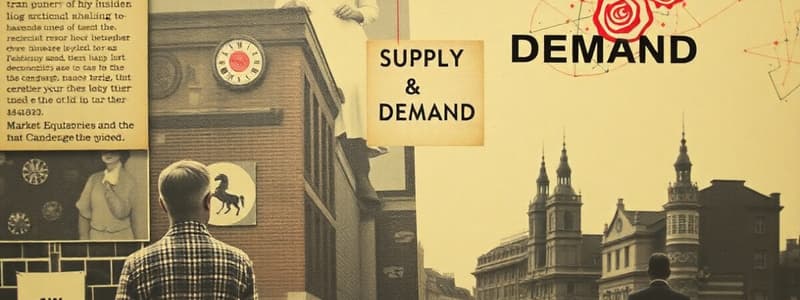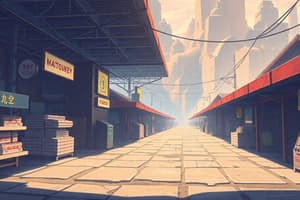Podcast
Questions and Answers
What is the primary focus of economics?
What is the primary focus of economics?
- The study of environmental science
- The study of scarce resources and their allocation (correct)
- The study of historical events
- The study of political systems
Which of the following is a key function analyzed in economics?
Which of the following is a key function analyzed in economics?
- Production
- Distribution
- Consumption
- All of the above (correct)
What is the study of individual economic agents called?
What is the study of individual economic agents called?
- Econometrics
- Behavioral economics
- Microeconomics (correct)
- Macroeconomics
What is the term for the amount of a good or service producers offer at a specific price?
What is the term for the amount of a good or service producers offer at a specific price?
What does demand represent in economics?
What does demand represent in economics?
What occurs where supply and demand curves intersect?
What occurs where supply and demand curves intersect?
What does elasticity measure?
What does elasticity measure?
Which of the following is an example of a market structure?
Which of the following is an example of a market structure?
Which cost functions are important for firms in making production decisions?
Which cost functions are important for firms in making production decisions?
What is a cost or benefit not reflected in market prices called?
What is a cost or benefit not reflected in market prices called?
What focuses on the behavior of the economy as a whole?
What focuses on the behavior of the economy as a whole?
Which of the following measures the total value of goods and services produced within a country?
Which of the following measures the total value of goods and services produced within a country?
What is a sustained increase in the general price level known as?
What is a sustained increase in the general price level known as?
The percentage of the labor force seeking employment but unable to find work is known as:
The percentage of the labor force seeking employment but unable to find work is known as:
What are recurring patterns of economic expansion and contraction called?
What are recurring patterns of economic expansion and contraction called?
Government spending and taxation are part of what policy?
Government spending and taxation are part of what policy?
Managing the money supply and interest rates involves what policy?
Managing the money supply and interest rates involves what policy?
The exchange of goods and services between countries is known as:
The exchange of goods and services between countries is known as:
What determines the value of one currency relative to another?
What determines the value of one currency relative to another?
What leads to higher living standards and improved economic well-being?
What leads to higher living standards and improved economic well-being?
Flashcards
What is Economics?
What is Economics?
The study of how societies allocate scarce resources to satisfy unlimited wants and needs.
What is Microeconomics?
What is Microeconomics?
Focuses on individual economic agents like households, firms, and markets.
What is Supply?
What is Supply?
The quantity of a good or service producers offer at a specific price.
What is Demand?
What is Demand?
Signup and view all the flashcards
What is Market Equilibrium?
What is Market Equilibrium?
Signup and view all the flashcards
What is Elasticity?
What is Elasticity?
Signup and view all the flashcards
What are Market Structures?
What are Market Structures?
Signup and view all the flashcards
What are Fixed Costs?
What are Fixed Costs?
Signup and view all the flashcards
What are Variable Costs?
What are Variable Costs?
Signup and view all the flashcards
What are Total Costs?
What are Total Costs?
Signup and view all the flashcards
What are Marginal Costs?
What are Marginal Costs?
Signup and view all the flashcards
What are Externalities?
What are Externalities?
Signup and view all the flashcards
What are Public Goods?
What are Public Goods?
Signup and view all the flashcards
What is Macroeconomics?
What is Macroeconomics?
Signup and view all the flashcards
What is GDP?
What is GDP?
Signup and view all the flashcards
What is Inflation?
What is Inflation?
Signup and view all the flashcards
What is Unemployment?
What is Unemployment?
Signup and view all the flashcards
What are Business Cycles?
What are Business Cycles?
Signup and view all the flashcards
What is Fiscal Policy?
What is Fiscal Policy?
Signup and view all the flashcards
What is Monetary Policy?
What is Monetary Policy?
Signup and view all the flashcards
Study Notes
- Economics is a social science that studies how individuals, businesses, governments, and societies make decisions about allocating scarce resources to satisfy their unlimited wants and needs.
- It analyzes the production, distribution, and consumption of goods and services
- It provides a framework for understanding how economies function and how to improve economic outcomes.
Microeconomics
- Microeconomics focuses on the behavior of individual economic agents, such as households, firms, and markets
- Supply and demand are fundamental concepts; supply refers to the quantity of a good or service that producers will offer at a given price, while demand represents the quantity that consumers are willing to purchase at that price
- Market equilibrium occurs where the supply and demand curves intersect, determining the market price and quantity
- Elasticity measures the responsiveness of one variable to a change in another, such as the price elasticity of demand, which indicates how much the quantity demanded changes in response to a change in price
- Market structures include perfect competition, monopoly, oligopoly, and monopolistic competition; each structure has different characteristics affecting pricing, output, and efficiency
- Cost functions include fixed, variable, total, and marginal costs, which are crucial for firms in making production decisions
- Different market failures can arise, like externalities (costs or benefits not reflected in market prices) and public goods (non-excludable and non-rivalrous), leading to inefficient resource allocation
- Governments intervene through regulations, taxes, and subsidies to correct market failures and improve economic outcomes
Macroeconomics
- Macroeconomics examines the behavior of the economy as a whole, focusing on aggregate variables such as GDP, inflation, and unemployment
- GDP (Gross Domestic Product) measures the total value of goods and services produced within a country's borders during a specific period; it is a key indicator of economic activity and growth
- Inflation refers to a sustained increase in the general price level; it erodes purchasing power and can distort economic decision-making
- Unemployment represents the percentage of the labor force that is actively seeking employment but unable to find work; it indicates the underutilization of labor resources
- Business cycles are recurring patterns of economic expansion and contraction; they consist of periods of growth (booms) and periods of decline (recessions)
- Fiscal policy involves government spending and taxation to influence the economy; it can be used to stimulate growth during recessions or to cool down an overheating economy
- Monetary policy involves central banks managing the money supply and interest rates to influence economic activity; lowering interest rates can encourage borrowing and investment, while raising rates can curb inflation
- International trade involves the exchange of goods and services between countries; it leads to specialization, increased competition, and access to a wider variety of products
- Exchange rates determine the value of one currency relative to another; they affect the prices of exports and imports and play a crucial role in international trade and finance
- Economic growth refers to the increase in the production of goods and services over time; it leads to higher living standards and improved economic well-being
Studying That Suits You
Use AI to generate personalized quizzes and flashcards to suit your learning preferences.




